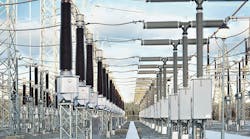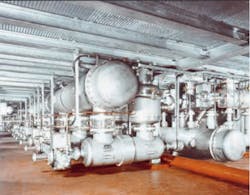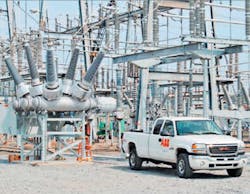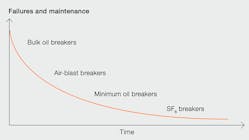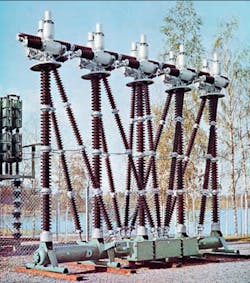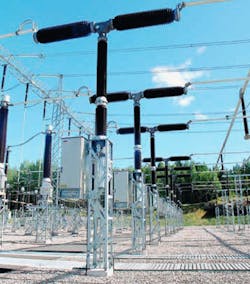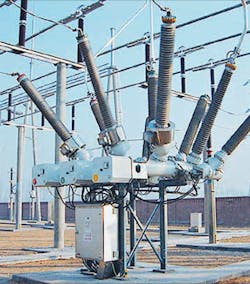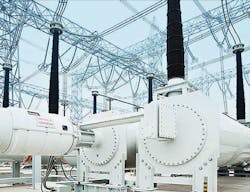Depending on the convention of the local electrical power industry, high voltage is from 52 kV to 72.5 kV, and has a practical upper limit of about 1,200 kV, although earlier studies and demonstration projects are as high as 1,500 kV. The technical challenge from the beginning for high-voltage products has been the battle between mechanical, thermal and dielectric properties of the materials used to make them, starting with paper and oil for insulation, and air, oil and sulfur-hexafluoride-gas-immersed switching devices to interrupt the current. Besides the power transformers, which at that time already existed, other high-voltage components had to be developed to complete the grid, including power capacitors, high-voltage resistors, overvoltage protection devices and, of course, measurement transformers for current and voltage. All of these devices were connected to electromechanical relays to control and monitor the primary equipment.
Since those early times, electromechanical equipment has undergone significant improvement as a more detailed understanding has emerged of the basic physics of materials under electrical and thermal stress, in particular understanding of the dominant insulation media oil, paper and porcelain. For switching devices, bulk oil breakers were later replaced by minimum oil breakers, where the oil volume was reduced to the amount needed for extinguishing the arc. Later on, it was found that oil could be replaced by introducing a high-pressure air flow into the arcing zone. Only later were the phenomenal dielectric properties of sulfur hexafluoride (SF6) gas discovered, which resulted in the introduction of the first high-voltage gas-insulated switchgear (GIS) by BBC, one of ABB's parent companies, in 1965 ➔ 1. From then on the focus was on improving the understanding of breaker physics, which resulted in more powerful interrupters capable of interrupting short-circuit currents from 25 kA typically up to 80 kA, and from many series-connected interrupters to a maximum of one interrupting unit for up to 420 kV and even 550 kV circuit breakers. As an example: In 1998 ABB was the first manufacturer to provide a dead tank breaker (DTB) with 245 kV and rated short-circuit currents of 80 kA for the US market ➔ 2.
Additionally, the increased knowledge of thermal and dielectric gas properties paired with computer simulations of hot gas flow helped to further develop basic switchgear function to a level where, according to latest Cigre statistics, the reliability of SF6 circuit breakers improved to a low value of 0.3 failures per 100 circuit- breaker-years of operation, which is an order of magnitude better than the first two pressure SF6 breakers, and cannot even compare with devices based on earlier oil technology ➔ 5.
➔ 3 shows 420 kV live tank breakers (LTBs) from the late 1960s, in comparison with a modern type of LTBET2, with two interrupting units in series and no need for grading capacitors ➔ 4.
Innovation in high-voltage equipment
Different global requirements have led to the emergence of various types of high-voltage switchgear ➔ 6. Primarily, these include LTBs, in which the main insulation is air and the active part on high-voltage potential is connected to overhead power lines; DTBs, a version predominantly used in the United States, in which the interrupter is contained in a pressurized metal tank on ground potential; and GIS, which is used mainly indoors or wherever a small footprint is essential. Liberalized electric power markets in various countries have made reliability, compactness and efficient use of substation area more and more important. ABB pioneered the development of switchgear products with additional integrated functions like the Plug and Switch System (PASS), which led to the development of mixed technology switchgear that provide a functional blend of AIS (air-insulated switchgear) and GIS technologies.
Launched in the late 1990s, PASS is a modular concept that combines the main breaking function in a metal enclosure (as in a DTB) with a combined disconnecting/ earthing switch and current measurement. PASS is a very versatile HV product. It can be configured to fit all AIS substation layouts, such as single busbar, double busbar or H-bridge, and can be installed in new installations or retrofitted into existing substations for substantial space savings. This new HV switching machine comes fully factory assembled and tested, which means minimum time for field installations, as well as reduced lead times in tendering and overall project execution. PASS and in general mixed-technology switchgear solutions are becoming more and more popular, in particular because they offer greater flexibility in new substation layouts. Since its introduction, ABB has sold more than 8,000 PASS or hybrid switchgear bays worldwide ➔ 7.
Another example of pioneering HV switchgear concepts is the disconnecting circuit breaker (DCB) first launched by ABB in 2000. The most unreliable switching device in AIS substations is the open-air disconnector, used primarily to isolate circuit breakers or other HV components for maintenance purposes. In a DCB, the air-insulated disconnector is simply avoided and becomes part of the SF6 gas protected main breaker. As the maintenance interval of modern HV SF6 circuit breakers is now 15 years or more, keeping unreliable air disconnectors makes no sense in many cases. With the introduction of the IEC standard for DCBs (IEC 62271-108) in 2005, the acceptance of this technology grew significantly, resulting in more than 1,500 ABB DCB installations worldwide for all voltage levels up to 550 kV.
Beside compactness, the most important advantage of integrating functions is reliability, because more components are in a protected gas environment. The move from electromechanical relays to digital protection devices has replaced bulky instrument transformers used to measure voltage and currents as well as multiple redundant electromechanical tripping relays. In their place are a few sensors with local preprocessing intelligence, connected to numerical bay and station control devices by low-power analog signals, or fiber-optic digital connections. Pioneered by ABB, these devices represent the first step into the world of digital substations, later to become widely known as smart substations. For example, in the late 1990s ABB introduced a smart GIS solution featuring electronic current sensors with optical voltage transducers, supervision of actuators and integrated digital protection and control.
The big breakthrough for digital substations came with the emergence of the international substation automation standard IEC 61850, which solved the engineering nightmare of integrating various proprietary solutions. Not only was the problem of interoperability between devices from different suppliers solved, but IEC 61850 also created a future-proof standard that is immune to the fast developing and ever-changing digital world.
Recent developments and outlook
The continuous drive to increase reliability and availability of electrical power is reflected in the latest revision of the HV switchgear standard IEC 62271-100, where new tough requirements were set for mechanical (M2) and capacitive switching (C2), as well as electrical endurance (E2). These efforts, in combination with smart grid initiatives, have resulted in an increased trend toward online monitoring of all primary switchgear functions at the bay and substation level. This is necessary to move away from fixed maintenance schedules, and to be able to plan well ahead for revised maintenance schedules, minimizing outage times. The new generation of smart substations will implement what has been learned in the past, increasing the safe, reliable and flexible operation of HV equipment that is capable of meeting future demands on the AC power grid.
Another HV challenge is the efficient transmission of bulk power over long distances. Recently, new installations of ultrahigh- voltage (UHV) technology demonstration projects have emerged in China and India. One can say that the rise of UHV technology (defined as voltages above 800 kV for AC transmission, and 800 kV and above for direct current or DC transmission) was triggered by energy-hungry emerging countries, where abundant but remote energy supplies had to be flexibly connected to mega-cities and fast-growing industrial load centers far away. UHVAC power lines are also being planned as a strong backbone to support the rapidly evolving grid infrastructure. One example is the 1,100 kV ultrahigh-voltage alternating current (UHVAC) demonstration project in China, a 650 km power line from Jindongnan via Nanyang to Jingmen, with a maximum transmission capacity of more than 5,000 MVA.
ABB participated in a joint effort with a local supplier to design and deliver the first 1,100 kV hybrid GIS (mixed technology switchgear) for the Jingmen substation, which successfully went into operation in December 2008 ➔ 8.
Despite the controversy over UHV transmission – in particular its commercial viability – State Grid Cooperation of China decided to boost HVDC technology to UHV levels as well. Starting with +/– 500 kV to 800 kV DC, the first commercial installations went into operation in 2010. ABB has in recent years successfully completed tests of all 1,100 kV UHVDC components, and is ready for future HV grids in the years to come ➔ 9.
As a world leader in HV products, ABB is committed to improving and exploring advanced HV technologies, and investing in pilot installation projects to explore new technologies that sustainably support the growth in demand of electric power around the world.
Fredi Stucki
ABB Power Products, High Voltage Products
Zurich, Switzerland
[email protected]
